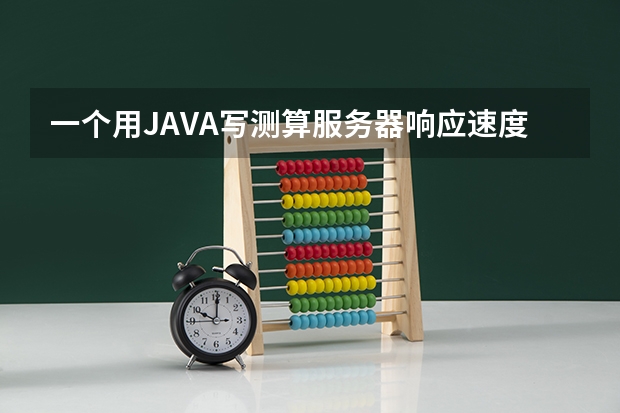一个用JAVA写测算服务器响应速度程序(我的java排序算法程序,想计算运行时间,结果为0,求各路高手解答。)
2024-03-17 00:43:39 | 我爱编程网
本文目录一览:

一个用JAVA写测算服务器响应速度程序
任务描述
需要做一个程序 对某一服务器运行的web server进行测算 看对提出的request做出相应的时间 并且在多个request同时提出时的响应时间
计划
因为java sdk中包含有比较全面的class能够对等多种协议的处理方法进行了封装 用起来比较方便 能够在比较短的时间内快速开发出这一测算工具
需要 个功能
a 因为不是仅仅对一个web server或者一个form进行测算 所以需要程序能够灵活处理 完成各种工作 我采用了配置文件的形式 让程序从配置文件中读取数据 并作相应动作
b 需要采用多线程方式 对同一个web server提交多次request
开发过程
(读者可以跟随这一过程 自己动手写代码 到全文结束 就能有一个完整可用的程序了)
主要的工作都有TestThread来完成 代码如下 class TestThread implements Runnable { Parameter param; TestThread(Parameter par) { param = par; } public void run() { long time = new Date() getTime(); try { URL target = param url; HttpURLConnection conn = (HttpURLConnection) target openConnection(); conn setRequestMethod(thod); int i; for( i = ; i < param length; i++ ) { conn setRequestProperty(param key[i] param value[i]); } nnect(); BufferedReader in = new BufferedReader( new InputStreamReader(conn getInputStream())); String inputLine; while( (inputLine = in readLine()) != null ); } catch(Exception e) { } long time = new Date() getTime(); System out println(time time ); } } class TestThread implements Runnable 而不是用extends Thread 的好处是独立设计一个类 这个类还可以extends其它的class 而不是单独的extends Thread 另外一个好处是 可以把处理方法放在各个不同的方法中 然后在void run()中调用 程序结构比较清晰
程序工作如下
在初始化一个TestThread实例的时候 接受一个Parameter参数(稍候介绍) 并在线程启动时 计算开始的时间 向目标机器发送请求包 接受目标机器的返回结果 再次计算时间 并得到两次时间之差 这就是服务器的响应时间
具体程序可以自己看懂 就不多说了
class Parameter { URL url; String[] key; String[] value; String method; int length = ; public void addPair(String k String v) { Array set(key length k); Array set(value length v); length++; } } 是用来传递参数的一个类 参数是主程序从文件中读出来并存入这个类的一个对象里 然后通过初始化TestThread传递给它的对象
public class TestServer { static int loopTimes = ; public Parameter readFromArgFile(String str){ FileInputStream fileInput; BufferedReader br; Parameter param = new Parameter(); try { fileInput = new FileInputStream(new File(str)); br = new BufferedReader( new InputStreamReader( fileInput )); String line; while( (line = br readLine()) != null ) { if( line startsWith( URL ) == true && line indexOf( = ) >= ) { int f = line indexOf( = ); String urlstring = line substring(f+ ); urlstring trim(); param url = new URL(urlstring); } else if( line startsWith( METHOD ) == true && line indexOf( = ) >= ) { int f = line indexOf( = ); String method = line substring(f+ ); method trim(); thod = method; } else if( line indexOf( = ) != ) { int f = line indexOf( = ); String key = line substring( f ); String value = line substring(f+ ); param addPair(key trim() value trim()); } } fileInput close(); br close(); } catch(FileNotFoundException e) { System out println( File + str + not found ); } catch(NullPointerException e) { } catch(IOException e) { System out println(e); } return param; } public static void main(String[] args) { int i; int j; Parameter param; TestServer tester = new TestServer(); for(i = ; i < Array getLength(args); i++) { param = tester readFromArgFile(args[i]); for(j = ; j < loopTimes; j++) { Thread th = new Thread(new TestThread(param)); th start(); } } } } 主程序main也比较简单 从命令行参数中读取文件名 并依次打开 读取其中的配置参数 创建Parameter对象 并传递给TestThread对象 然后启动TestThread线程 需要注意的是其中的错误处理 当发现某个文件读写错误的时候 是跳过这个文件而读取下一个文件 而不是简单的退出
就这么简单 (当然 适当的改写一下 就可以做一个加贴机或者灌水机之类的东东 那是你的爱好 和我无关 ))
程序全文列在最后 并附上了说明
lishixinzhi/Article/program/Java/hx/201311/27192

我的java排序算法程序,想计算运行时间,结果为0,求各路高手解答。
因为你的数太少,现在的CPU运行速度很快的 你的代码没贴完整 我自己修改了下弄了个完整的 输入了10000个整数 运行时间大概是110毫秒。
public class Test5 {
public static void main(String[] args) {
long begin = System.currentTimeMillis();
int[] s_array = new int[10000];
int n = s_array.length;
for (int i = 0; i < n; i++) {
s_array[i] = i;
}
for (int i = 0; i < n - 1; i++) {
int k = i;
for (int j = i + 1; j < n; j++) {
if (s_array[j] < s_array[k])
k = j;
}
if (k != i) {
int temp;
temp = s_array[i];
s_array[i] = s_array[k];
s_array[k] = temp;
}
}
long end = System.currentTimeMillis();
System.out.println();
System.out.print("排序结果:");
for (int i = 0; i < n; i++) {
System.out.print(s_array[i] + " ");
}
System.out.println();
System.out.println("选择排序法用时为:" + (end - begin));
System.out.println("选择排序法比较次数为:" + (n * (n - 1)) / 2);
}
}

java获取运行时间
我爱编程网(https://www.52biancheng.com)小编还为大家带来java获取运行时间的相关内容。
很多朋友都想知道java怎么获取运行时间?下面就一起来了解一下吧~我爱编程网
第一种是以毫秒为单位计算的。
//伪代码 long startTime=System.currentTimeMillis(); //获取开始时间 doSomeThing(); //测试的代码段 long endTime=System.currentTimeMillis(); //获取结束时间 System.out.println("程序运行时间: "+(end-start)+"ms"); //伪代码 long startTime=System.currentTimeMillis(); //获取开始时间 doSomeThing(); //测试的代码段 long endTime=System.currentTimeMillis(); //获取结束时间 System.out.println("程序运行时间: "+(end-start)+"ms");
第二种是以纳秒为单位计算的。 //伪代码 long startTime=System.nanoTime(); //获取开始时间 doSomeThing(); //测试的代码段 long endTime=System.nanoTime(); //获取结束时间 System.out.println("程序运行时间: "+(end-start)+"ns"); //伪代码 long startTime=System.nanoTime(); //获取开始时间 doSomeThing(); //测试的代码段 long endTime=System.nanoTime(); //获取结束时间 System.out.println("程序运行时间: "+(end-start)+"ns");
免责声明:文章内容来自网络,如有侵权请及时联系删除。
- 用php 自定义一函数,能够输入的整数,反序逐位输出。如输入3456,输 PHP中foreach函数用法?
- PHP strcmp定义和用法 php中统计数组的长度是那个函数?
- 关于如何解决mysqli()没有与之对应mysqli_field_name()问题
- PHP feof提示和注释(FileSystemPHP Filesystem 函数)
- php里面有多条UPDATE怎么优化?
- php和html怎么结合?
- chunk_split语法(SPLIT语言用法)
- php正则提取函数 PHP利用正则表达式截取字符串,preg_match_all()函数
- 使用fnmatch函数在PHP中进行模式匹配操作 php判断某字符串是否符合电子邮件格式的正则表达式
- php程序中,定义一个常量,常量名为什么非要用双引号呢? 例如:define("NAME",10);
- php函数处理排序 sortphp sort函数
- 怎么设置html文字背景颜色
-
 在线急求 PHP解密(PHP解密 (base64_decode))
在线急求 PHP解密(PHP解密 (base64_decode))2025-02-01 20:24:39
-
 php获取当前页面url(URL、表单数据、IP等处理类,url表单_PHP教程)
php获取当前页面url(URL、表单数据、IP等处理类,url表单_PHP教程)2025-02-12 03:21:37
-
 PHP文件及运行(适合PHP初学者)(PHP开发常用的4种运行方式)
PHP文件及运行(适合PHP初学者)(PHP开发常用的4种运行方式)2025-02-10 15:19:48
-
 PHP开发中(Array)数组函数大全(100个最常用的PHP函数(记得收藏哦))
PHP开发中(Array)数组函数大全(100个最常用的PHP函数(记得收藏哦))2025-01-28 17:58:32
-
 php 日期加减法问题(php 时间加减)
php 日期加减法问题(php 时间加减)2024-11-22 05:08:01
-
 我是php新手,请问swoole怎么解密呢?
我是php新手,请问swoole怎么解密呢?2024-09-10 08:50:00